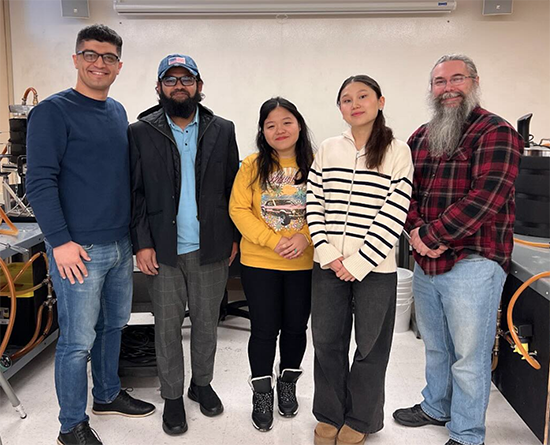PSNergy and Gannon University develop carbon foam technology for furnace monitoring
Nathan Snizaski
Oct 3, 2025
Pennsylvania is home to many metals-processing companies that rely on heat treating—the precise heating and cooling of steel—to strengthen and shape products used in construction, transportation, and manufacturing. One of the industry’s biggest challenges is accurately measuring the actual temperature of steel parts during heat treating. Because furnaces operate at extremely high temperatures and many products have complex shapes, attaching and protecting temperature sensors is a challenging task.
To address this challenge, researchers at Gannon University and PSNergy (Erie, PA) are developing a new heat-resistant carbon foam as a promising insulator that protects sensors from intense heat. Using additive manufacturing, this foam can be shaped to fit intricate steel components, offering an efficient and sustainable method to enhance heat-treatment monitoring.
Traditionally, companies have relied on an annual uniformity survey to check furnace performance. In this process, a third-party surveyor places multiple sensors, known as thermocouples, inside an empty furnace to measure the evenness of heat distribution. While effective, this method halts production, requires the use of outside contractors, and only provides a snapshot of the furnace's performance.

Carbon foam research team (left to right): Dr. Saeed Tiari, Baudrul Mohammad Shahjalal, Shashikala Chakma, Altynai Taalaibekova, Dr. Davide Piovesan
“Many of our customers rely on a uniformity survey done occasionally—possibly only once per year—to confirm that their furnace is operating correctly,” explains Carl Nicolia, president of PSNergy. “After that, the surveyor will conduct in-process testing to verify that products are being treated consistently. But it’s not continuous, real-time data.”
PSNergy partnered with Gannon University to explore the feasibility of attaching a thermocouple directly to steel products as they pass through a furnace, enabling real-time monitoring of furnace conditions. This novel product would serve a significant industry need and provide companies with continuous evidence that every batch is being heat-treated correctly.
“Our thought process was, if we could insulate the electronic components of the thermocouple enough to withstand a one-hour cycle at 1200 degrees Fahrenheit, that would address a massive customer need,” says Nicolia. “It would provide companies with definitive evidence that every batch is meeting standards without shutting down production for a uniformity survey.”
Beyond quality assurance, Nicolia highlights the potential for efficiency: “If I can cut 20% off my cycle time using this product, I can produce more material. More production means more revenue, more profit, and less energy used. Productivity and reduced emissions go hand in hand.”
To make this innovation possible, researchers at Gannon University focused on finding the right material to insulate the thermocouple from extreme heat. Davide Piovesan, professor of biomedical engineering, led the Gannon research team.
Piovesan explains that a core challenge of developing this product is space limitation: sensors need to be miniaturized from a material that can absorb heat for an extended period without changing the internal temperature where the electronics are located.
“At the beginning of the project, Dr. Saeed Tiari (formerly at Gannon, now at Widener University) was also part of the team. He helped our team connect with Carl at PSNergy,” says Piovesan. “Tiari is an expert in different types of heat exchange, and I'm more on the side of materials. We put our minds together to look at materials that are usually not used in this type of environment, but that could have the characteristics of storing a lot of the heat and maintaining its temperature to preserve embedded electronics.”
The research team explored the use of beer spent grain and hemp as source materials. These agricultural byproducts can be repurposed into a heat-resistant carbon foam with the ideal porosity to protect sensors. Additive manufacturing allows the foam to be shaped into complex forms that fit snugly around steel parts, ensuring accurate data collection.
“We’re experimenting with different combinations of additives that carbonize very slowly,” says Piovesan. “That means the internal part of the foam stays at a constant temperature for an extended period of time, preserving the electronics inside.”
Being able to work with Piovesan and his students at Gannon helped us overcome dimensional challenges and start thinking seriously about commercializing this product.
Carl Nicolia, President, PSNergy
For PSNergy, the partnership with Gannon through the Manufacturing PA Innovation Program was essential.
“Identifying the ideal material for an insulation sensor product was beyond our capability,” says Nicolia. “Being able to work with Piovesan and his students at Gannon helped us overcome dimensional challenges and start thinking seriously about commercializing this product.”
For the students, the experience was equally valuable. “Carl gave us an opportunity to look at a problem that has real meaning in the industry,” says Piovesan. “It was great to see how the students embraced this challenge. When they were able to maintain the integrity of the foam after 55 minutes of heat treating, they were ecstatic. They were caught in the act of learning and were able to solve many of the aspects of this problem, which was exciting for the entire team.”
Nicolia adds that he hopes projects like this encourage students to stay in Pennsylvania after graduation.
“The talent we need for our industries to thrive is right under our noses. You don’t need to look out of state. There are so many great universities across Pennsylvania with very talented students. If we can give them industry experience and interesting problems to solve, hopefully, they will stay in Erie or elsewhere in the Commonwealth. That’s the goal to keep manufacturing in Pennsylvania strong.”